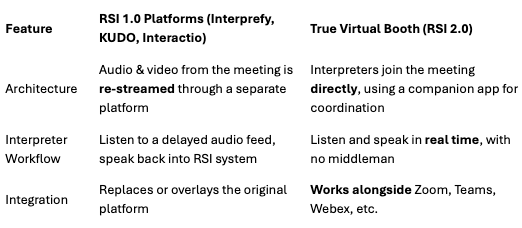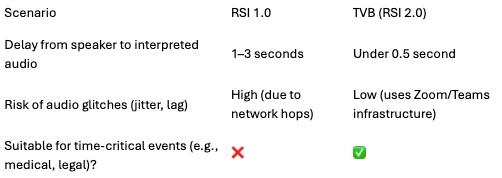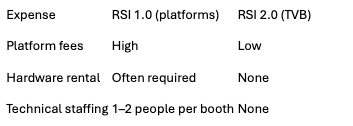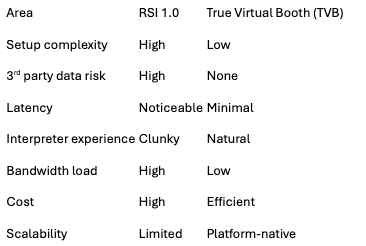A deep yet digestible guide to how TVB (RSI 2.0) outperforms legacy RSI solutions (RSI 1.0) like Interprefy, KUDO, and Interactio in every mission-critical area.
Remote Simultaneous Interpretation (RSI) has been essential for global events, allowing audiences and speakers to interact in real time across languages. Yet, behind the scenes, a silent revolution is happening — one that most event organizers and procurement decision-makers haven’t fully grasped. It’s called the True Virtual Booth (TVB), and it’s rewriting the rulebook for RSI.
Unlike traditional RSI platforms (e.g., Interprefy, KUDO, Interactio), which rely on complex re-streaming architectures, TVB lets interpreters work directly inside the meeting platform — whether Zoom, Teams, or Webex. The impact? Faster performance, fewer failure points, lower costs, and ironclad security.
This article offers an expert-neutral, plain-language comparison of these two categories — RSI 1.0 (legacy platforms) vs. RSI 2.0 (TVB) — to help you decide the best path forward for your multilingual events.
🧠 What’s the Fundamental Difference?

Verdict: TVB removes the middle layer entirely. What used to require a multi-server setup now happens within your existing meeting tool — natively and instantly.
🔐 Security: Where Is Your Meeting Audio Going?
Legacy RSI platforms route your meeting audio through third-party servers. For many clients — especially in finance, government, or pharma — this is a major compliance red flag.
TVB avoids this entirely. Interpreters hear the meeting as participants, and speak back into it. No external routing. No unintentional data exposure.
“With TVB, there is no re-streaming or platform injection. The interpretation happens within the original meeting. Security is preserved by design.”
⚡ Latency: When Every Second Counts

Real-world example: At a live surgical stream, a 12-second interpreter delay via RSI 1.0 caused critical confusion. With TVB, latency is near-instant.
🧰 Logistics: Tech Crew or Just the Interpreters?
Traditional RSI setups often demand:
TVB requires:
That’s it. No special hardware. No multi-point setup. No tech circus.
🌐 Bandwidth: TVB Is Lighter by Design
WebRTC (used by most RSI 1.0 platforms) is bandwidth-hungry and not firewall-friendly.
TVB leverages the meeting platform’s audio. It’s already optimized. No duplication. No special firewall rules. That means:
💸 Cost and Manpower

TVB cuts not just cost — but invisible cost: coordination time, event delays, tech risk.
🎛️ Flexibility: Any Platform, Any Format
TVB supports hybrid and virtual events on your platform of choice. Whether it’s:
TVB is plug-and-play. Interpreters simply log in. No platform migration. No audience retraining.
✅ Bottom Line: TVB Is the Future of RSI
Let’s recap:

Conclusion:
TVB isn’t merely an incremental improvement — it’s a fundamental re-architecture of remote interpretation that aligns with modern demands for security, efficiency, and simplicity. While traditional RSI platforms served a purpose in the early digital era, their operational constraints and hidden costs no longer match enterprise requirements.
For organizations hosting mission-critical multilingual events, TVB delivers the trifecta legacy solutions cannot: native security, human-paced dialogue, and radical operational simplicity. The transition isn’t about choosing a new vendor — it’s about adopting a superior technical paradigm.
For a better understanding of True Virtual Booth (TVB), this webinar by the Globalization and Localization Association (GALA) Special Interest Group (SIG) on Interpreting.